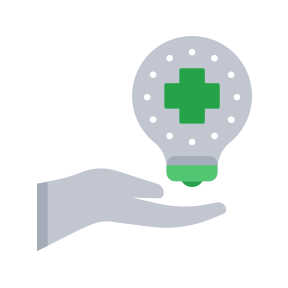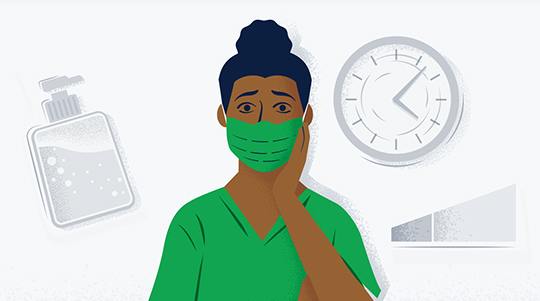Hospital infection control: How to drive shared accountability
Infection preventionists can lead change management in healthcare.

You’re an infection preventionist, and you’re seeing that the numbers for certain healthcare-associated infections (HAIs) have been creeping upward in your organization. In getting to the root cause of a recent central line-associated bloodstream infection (CLABSI) event, you’ve discovered that the clinician who was changing a central line dressing at the bedside touched a bed rail that hadn’t been wiped down and then touched the patient. In the meantime, staff are in short supply or stretched thin, and they don’t have the time to take on one more project.
It’s quite a picture. Infection preventionists are challenged every day to meet expectations set by the Centers for Medicare & Medicaid Services (CMS) and other payors, not to mention their own organizations, to reach zero harm when it comes to preventing HAIs. The Centers for Disease Control and Prevention (CDC) reported significant progress in preventing some types of HAIs in the five years before the COVID-19 pandemic started in March 2020. However, on any given day about one in 31 hospital patients has at least one healthcare-associated infection.1
“The role of infection preventionist is branching out beyond acute care to other providers—long-term care, post-acute care and rehab are increasingly being tasked as active participants in infection prevention.”

Angela Newman
Medline Senior Director of Clinical Services
Key factors getting in the way of a successful infection prevention strategy
- Pathogens that cause disease are everywhere, with new ones on the rise. And others are becoming increasingly complex, making it more and more challenging for staff to prevent their spread.
- Patients are more complex and, with that, so is the care they require. Best practices are changing and evolving at a furious pace, even by healthcare standards.
- Hospital staff members are juggling multiple priorities during ongoing staff shortages.
- When patients are transferred from acute care to post-acute care settings, the risk for infection increases. The expectations of infection prevention also increase, especially among large integrated delivery networks (IDNs) that own and operate not only hospitals but also rehabilitation, long-term care facilities and home care services.
The Joint Commission, the Association for Professionals in Infection Control and Epidemiology (APIC) and other organizations have clear guidelines for best practices in preventing CLABSIs, catheter-associated urinary tract infections (CAUTI), surgical site infections (SSIs), hospital-onset C. difficile and hospital-onset MRSA.
Yet no one person can prevent these HAIs. Everyone needs to be engaged and involved to keep patients safe—from physicians and bedside nurses to clinicians in ancillary units, to the EVS teams responsible for keeping patient rooms clean, to materials managers responsible for supplying the right products.
But how do you influence people, most of whom don’t report to you, to follow best practices? How do you drive shared accountability across teams to prevent infection?
Change management—your choice of models and best practices
Just as there are best practices in infection prevention, the same holds true for change management, which, according to Harvard Business School, “drives the successful adoption and usage of change within a business.” Without it, transitions can be unpredictable and expensive in terms of both time and resources.2
In fact, as hospitals and health systems, especially large and growing IDNs, continue to evolve and adapt to new caregiving models, many are already using process improvement and change management tools and methodologies to transform their organizations.
If you Google “change management,” you’ll find a litany of models to choose from. In one article, the Kotter Change Management Model, the McKinsey 7-S Change Model, and the Prosci ADKAR® Change Management Model come up as among those considered most effective in the healthcare setting.3
If your organization is already using one of these or another change management model, your best bet is to use the same model. This way, physicians and staff, some of whom may wind up on your team, will already be familiar with the model’s change management concepts. And while their structures and approaches may vary, most change management models involve key principles that are essential to successfully driving shared accountability among team members.
Take, for example, the five sequential building blocks to the ADKAR model. Here are some ideas for how you can put these building blocks to work in infection prevention:

1 | Awareness of the need for change
Building awareness “means clearly explaining the drivers or opportunities that have resulted in the need for change. It also means addressing why a change is needed now and explaining the risk of not changing.”4
- Use key measurements such as the standardized infection rate (SIR) to raise awareness, show people how a hospital compares to national baseline data and help make the case for change.
“If the rates aren’t shared with staff, they have no idea,” says Donna Matocha, Medline Clinical Resource Manager. “The more hospitals communicate these rates, the better.”
- Use “zero harm” to raise general awareness and keep top of mind the organization’s priority of high-quality care and patient safety.
- Link your infection prevention initiative to the strategic goals of the health system or to external dynamics requiring change in healthcare or the local market.5
- Invite a third-party expert, who team members will see as non-threatening, to assess your organization’s current state and identify gaps in your infection prevention plan and processes.

2 | Desire to participate and support the change
“Continuing to focus on the reasons for change and not translating those into the personal and organizational motivating factors is a trap some change management practitioners face, and it can be very discouraging and annoying for employees. Your change management will require artful use of leaders as sponsors of change, and of supervisors and managers as coaches of employees during the change process.”6
- Empathize with key stakeholders—physicians, frontline caregivers and workers, EVS workers and supply leaders—by acknowledging their conflicts and/or concerns. Underscore the important role they play in keeping patients safe from infection through training and education, and engage them in the development of a common purpose and plan.
- Recruit physicians, nurses, EVS managers and materials managers as partners in new initiatives and/or to serve as champions for each group.
- Invite senior leaders’ engagement and involvement at the onset of any program or project. Those most influential in preventing HAIs are the chief nursing officer and chief medical officer but also unit managers, service chiefs, hospital epidemiologists, infection preventionists, environmental services and facilities managers.5

3 | Knowledge on how to change
“…there are two distinct types of knowledge. The first is knowledge on how to change (what to do during the transition), and … knowledge on how to perform effectively in the future state (knowledge on the ultimate skills and behaviors needed to support the change).”7
- Consider a two-tiered approach to defining best practices for infection prevention, with the first tier focused on standardizing both products and procedures and the second as a backup plan consisting of interventions if infection rates remain high.5
- Involve clinical educators, nurse preceptors and/or representatives from your organization’s learning and development team early on in your change management initiative. That way you can tailor training and education to the specific needs of a unit and/or product as well as facilitate the process.
- Make sure everyone at every level understands the three zones or areas where infection is transmitted: 1) environment of care, 2) human-to-human contact and 3) clinical practice—and practices infection prevention consistently.
- Connect the dots for frontline clinicians and workers by showing them how other routine best practices—good hand hygiene, in particular—are essential to the cause of keeping patients safe.

4 | Ability to implement desired skills and behavior
“There is often a large gap between knowledge and ability. Ensure that in addition to training to impart knowledge, employees are given sufficient tools for building their own ability.”8
- Encourage frontline staff to share their ideas for change and innovation, particularly when it comes to identifying gaps and standardizing evidence-based processes.
- Foster a bedside culture where staff are trained and empowered to call out in real time oversights or mistakes in infection prevention processes without retribution from physicians or managers.
- Leverage unit-based nursing councils and nursing practice councils. They have enormous influence when it comes to selecting new products and processes for preventing HAIs on their respective units, as well as training and educating staff.
- Take advantage of training and education materials and expertise offered by medical supply vendors when converting to new products.

5 | Reinforcement to sustain the change
“As the final building block of successful change, the focus on reinforcement needs to remain strong so that changes are sustained and deliver expected results over time.”9
- Make HAIs a regular agenda item in multidisciplinary team meetings, staff huddles, patient rounds and other meetings attended by key stakeholders. Invite those directly involved in successes to share their stories exemplifying best practices in infection prevention.
- Create and prominently post a key performance indicator (KPI) or similar tracking board for HAIs, hand hygiene posters and other key visuals. This will keep infection prevention best practices top of mind on units and drive compliance.
- Recognize and reward individual and team wins through shout-outs and award nominations, as well as through storytelling in meetings and other organizational communications.
Key takeaway
When it comes to controlling infections, driving shared accountability is key. Use change management principles and concepts to successfully engage clinicians, frontline staff, senior leaders and other stakeholders to work as a team. Make the most of the influence you have with people as they get to know you and understand that infection prevention is in everyone’s best interest. It’s an important part of providing high-quality patient care.
References:
- CDC. Healthcare-Associated Infections (HAIs). HAI Data. Retrieved September 3, 2021, from https://www.cdc.gov/hai/data/index.html.
- Harvard Business School Online. (Updated 2023, January 3). Organizational Change Management: What It Is & Why It’s Important. Business Insights Blog. What Is Organizational Change Management? | HBS Online
- Giva. (2021, May 10). The 3 Most Effective Organizational Change Management Models in Healthcare Practices.
- Prosci. Thought Leadership Articles. Awareness: The Prosci ADKAR Model. Retrieved September 3, 2021, from https://www.prosci.com/resources/articles/adkar-model-awareness.
- CDC. Strategies for Preventing Healthcare Associated Infections. Retrieved September 3, 2021, from: https://www.cdc.gov/infectioncontrol/pdf/strive/SP101-508.pdf.
- Prosci. Thought Leadership Articles. Desire: The Prosci ADKAR Model. Retrieved September 3, 2021, from https://www.prosci.com/resources/articles/adkar-model-desire.
- Prosci. Thought Leadership Articles. Knowledge: The Prosci ADKAR Model. Retrieved September 3, 2021, from https://www.prosci.com/resources/articles/adkar-model-knowledge.
- Prosci. Thought Leadership Articles. Ability: The Prosci ADKAR Model. Retrieved September 3, 2021, from https://www.prosci.com/resources/articles/adkar-model-ability.
- Prosci. Thought Leadership Articles. Reinforcement: The Prosci ADKAR Model. Retrieved September 3, 2021, from https://www.prosci.com/resources/articles/adkar-model-reinforcement.





